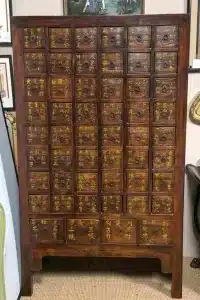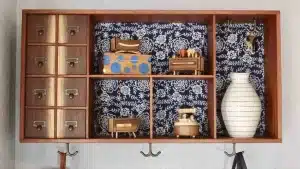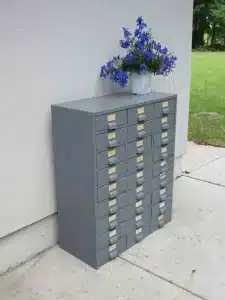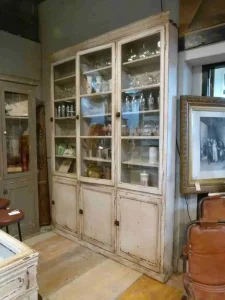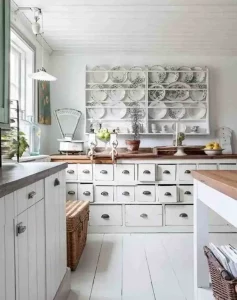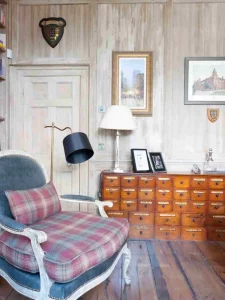Introduction
Have you ever wondered about those charming little drawers with a vintage vibe? The apothecary cabinet is no longer a thing of the past, although they have a rich historical significance. This creative storage furniture serves a variety of purposes in modern times. It is an ideal space organizer for your bedroom, kitchen, bathroom, office, etc.
In ancient times, apothecaries used these cabinets, specifically in pharmacies or medical institutions, to store and organize medicinal herbs. The functional design makes them super-handy for anyone to store and locate things efficiently.
From their roots as medicine keepers to becoming stylish accents in contemporary spaces, these cabinets have a story to tell. Join us as we uncover their history, unearth their common uses, discover where you can find these enchanting pieces today, and learn the art of preserving their charm.
What is an Apothecary Cabinet?
Deriving from the word ‘apothecary,’ it is a piece of storage furniture designed strategically with multiple small drawers. They are generally made of high-quality wood, such as oak or mahogany. They may also have glass doors or windows with knobs so that you can easily access the contents.
The shape and construction of cabinets can vary, with some models built with tall structures, whereas others are more squat and wider. The ample storage space and vintage charm attract most people regarding these cabinets. They may contain as many as 100 small compartments with a pretty symmetrical appearance.
Furthermore, apothecary chests come in many forms, including a narrow, dresser-like structure built with multiple drawers or more slender cabinets bedecked with widely stacked drawers. Many antique pieces boast beautifully sculpted patterns carved with intricate details, reflecting the artistic flair and professionalism of apothecaries back in the ancient era. Also, they used to be called ‘hundred-eye cabinets’ in China.
History of Apothecary Cabinet
You must be wondering where this growing appreciation for historic objects comes from. How old are these antique accents? Let’s begin with the ‘collector’s cabinet’ of the 18th century.
The Rijksmuseum of Amsterdam houses many such cabinets. The cabinets also improved sensory skills to recognize seeds, plants, gums, roots, and resins by their overall texture, shape, and scent. There were a lot of hidden drawers as well.
However, their true origins lie from the early 17th century in England. Before they used to be called ‘China cabinets’, they were first fashioned in England during the period of William and Mary. They brought the concept of apothecary cabinet from the Netherlands to showcase the popular fine china.
After furniture makers started crafting china cabinets in Britain, shops slowly began emerging mostly in the Northeast of Europe and America during that period. When Europeans came to America, they brought cool ideas with them. German, British, and French immigrants had their own styles, and that really impacted America. Around the early 1900s, we saw a bunch of awesome new china cabinet designs popping up, thanks to all these creative influences from Europe!
Apothecaries also became more significant during the Middle Ages. People realized the value of having skilled individuals who could make medicines and offer medical advice to the public. Those apothecaries were related to monasteries, where medicinal herbal knowledge was passed down through generations.
As the medical field evolved, so did the need for storage systems. However, you will still find this basic concept in various medicine storage places, such as chemists’, hospitals, etc. Even bedrooms, bathrooms, kitchens, etc., would love to use and appreciate these dedicated storage units.
Types of Apothecary Cabinet
Resembling vintage charm and storage functionality, these antique cabinets stand out as timeless treasures. These versatile pieces of furniture have evolved, offering a wide range of styles to cater to various tastes and preferences, as described below.
Traditional Apothecary Chest
The traditional chest showcases classic craftsmanship and intricate detailing. Crafted with rich, durable woods, these cabinets often feature small yet tons of drawers with antique-inspired pulls.
Traditional Chinese chests were generally built of elmwood or dark timber. Also, these were designed to retain Chinese people’s ancient way of doing business. Only glue and dowels were used to prepare those chests with zero requirement of nails.
Modern Apothecary Cabinet
They often present a minimalist and sleek alternative to traditional cabinets. Unlike conventional structures, these modern frames reject the vintage charm of the 19th and 20th centuries.
They fit appropriately for today’s natural world, characterized by clean lines and smooth surfaces, and are often made from materials like steel, plastic, or other metals.
Wall-Mounted Apothecary Chest
Modern wall-mounted cabinets crafted from solid wood are compact and smaller than traditional apothecary chests. They are designed to be mounted on the wall, usually above countertops or workspaces in kitchens, bathrooms, bedrooms, living areas, apothecary shops, etc. While ensuring easy access, this placement also saves you a lot of floor space.
Multi-Drawer Apothecary Cabinet
These cabinets are characterized by multiple drawers, each compartment typically labeled for easy identification of contents. They also contain small knobs or handles for better convenience.
Some cabinets feature metal elements, such as drawer pulls, label holders, or corner reinforcements. If it’s a traditional chest with vintage charm, it can contain even more than 100 drawers, whereas the number of drawers is relatively less in modern styles.
Glass-Fronted Apothecary Cabinet
These chests are built with transparent or translucent front panels, allowing a clear view of the contents inside. The frame of glass-fronted apothecary chests is typically made of wood, providing solid support. Glass-fronted versions often have multiple compartments or drawers for organized storage. The number and size of cases can vary.
Designs and Features of Apothecary Cabinet
Their antique designs are both functional and visually attractive. Considering the organization and available storage, these strategically designed cabinets made it easy for apothecaries to find what they sought.
Apothecary chests are typically made up of many small drawers, all the same size or in various sizes. This allowed their owners to store multiple herbs, spices, and medicines in an organized way.
Some cabinets also feature compartments for storing larger items or liquids. In terms of aesthetics, they are 10/10. They often had decorative features such as moldings and carvings.
Artisans primarily designed antique apothecary cabinets more sophisticatedly to store herbs, spices, and medicines. These storage items served to create a variety of remedies, from simple ointments to complex concoctions
In recent years, people started using these cabinets as popular decorative items. They can add a touch of vintage charm to any room.
Brilliant drawers, digital labels, and even climate-controlled compartments are emerging. Bespoke designs and modular components cater to individual needs and preferences. However, the core principles of organization, protection, and aesthetics remain timeless.
From humble beginnings to ornate showcases and from functional workstations to vintage treasures, they continue to captivate us with their unique blend of utility and beauty.
Common Uses of Apothecary Cabinet
Centuries ago, before big pharmacies and modern medicine, there were apothecaries. These were like the original medicine experts. They didn’t have fancy labs, so they used plants, roots, and natural things to make medicines.
Apothecaries needed a special place to store their magical ingredients and tools, and that’s where the apothecary’s chests came into play. Each drawer, shelf, or compartment holds a special ingredient for making remedies. They were also kept separate to preserve the smell of herbs.
One drawer might have dried leaves for tea; another could have weird-shaped roots for potions, and so on. As time marched on, science and medicine evolved. Apothecaries became more sophisticated, and their cabinets adapted. The designs became more organized, with labels and tiny drawers for easy access to specific herbs.
Today, apothecary cabinets aren’t just relics of the past. People still love them for their charm and usefulness. You might find them in homes, not for making magical potions, but as stylish storage. Crafters love them for storing beads, buttons, and small items. They are also used in spaces like kitchens, bathrooms, bedrooms, etc., in different styles, as mentioned above.
You can utilize these vintage apothecary chests in your interiors in various ways. Have a look at some of the coolest tips below!
Kitchen Islands & Storage Counters
Use it as a vintage kitchen table to store tons of your items in an effectively organized manner. You can transform it into an island by placing a solid countertop material. The butcher block adds warmth, marble exudes elegance, and stainless steel screams modern. Ensure the countertop can handle hot pots and spills. Consider overhangs for seating or extra prep space.
Console Table for Entryways
Multiple drawers and charming vintage vibes of antique apothecary cabinet lend themselves perfectly to repurposing as eye-catching console tables in your entryway. Choose a cabinet size that proportions well with your entryway, avoiding overwhelming the space.
Don’t be afraid to customize! Paint it with a vibrant hue and stencil design, or add unique knobs for a personalized touch. For a modern minimalist aesthetic, sleek metal-framed cabinets with clean lines and pops of color would be ideal to create a contemporary look.
Console Table for Living Room
Forget about the struggle of overflowing ottomans and precariously balanced coasters. Apothecary cabinets are storage champions, wielding an arsenal of drawers and compartments that can tame the living room chaos.
Envision a distressed wooden cabinet with woven baskets and vintage books stacked atop. This evokes a cozy, farmhouse vibe, perfect for curling up with a good book.
Or you can transform a drawer into a discreet cocktail haven. Stock it with your favorite spirits, liqueurs, and bitters, and impress your guests with your mixology prowess.
Where to Find Apothecary Chests
Find these vintage apothecary chests on various online platforms, as mentioned below.
Amazon
You can narrow your search by specifying features, sizes, or styles. Check customer reviews to get insights into the quality and satisfaction of previous buyers.
Alibaba
Alibaba offers various products from sellers, including furniture specialists. You can find different styles, sizes, and materials of modern apothecary cabinet to suit your preferences.
Wayfair
The collection boasts an array of options, from multifunctional chests to antique French country cottage cabinets and solid wood accent chests. Whether you’re seeking versatile storage solutions or a piece that adds a touch of vintage charm to your space, Wayfair’s selection caters to different tastes and preferences.
Walmart
Explore the different styles and find the perfect addition that seamlessly blends with your living space. With Walmart’s commitment to quality and variety, enhancing your home with a stylish apothecary cabinet is just a click away.
eBay
Embark on a journey through a diverse selection of vintage apothecary chests on eBay, where style meets affordability. Whether aiming for a modern look or a classic aesthetic, it has every style to suit your home decor.
1stDIBS
Dive into the assortment to discover well-crafted apothecary chests that blend seamlessly with various decor styles. This website covers every category, from industrial cabinets to multi-drawer chests to highly modern cabinets that will compliment you.
Maintenance & Cleaning Tips
It’s essential to preserve their appearance and functionality over time with regular cleaning. Given below are some general tips:
Regular Dusting
Dust the apothecary cabinet regularly using a soft, lint-free cloth or microfiber duster. This helps prevent dust buildup, which can dull the cabinet’s finish over time.
Avoid Harsh Cleaners
Use mild, non-abrasive cleaners when necessary. Harsh chemicals can damage the finish of the cabinet. Opt for a mild soap and water solution or a specialized wood cleaner.
Spot Cleaning
Immediately clean up spills or spots to prevent them from becoming stains. Use a damp cloth to wipe away spills gently, then thoroughly dry the area.
Avoid Direct Sunlight
Place the apothecary cabinet away from direct sunlight. Prolonged exposure to sunlight can cause the wood to fade and the finish to deteriorate.
Polishing
Periodically polish the cabinet with a high-quality wood polish to enhance its luster. Ensure the polish is suitable for the type of wood and finish on your cabinet.
Hardware Care
Check and tighten any loose hardware, such as handles or knobs, regularly. This ensures that the cabinet remains sturdy and functional.
Humidity Control
Maintain a stable humidity level in the room where the cabinet is located. Fluctuations in humidity can cause wood to expand or contract, leading to issues like warping.
Avoid Sharp Objects
Be cautious when placing or moving items on or around the cabinet to avoid scratches. Use felt pads or coasters under objects to prevent scratches or marks.
Lubricate Hinges
If your cabinet hinges, lubricate them occasionally with a small amount of silicone-based lubricant to ensure smooth operation.
Regular Inspection
Periodically inspect the cabinet for any signs of damage or wear. Please address any issues promptly to prevent them from becoming more serious.
Conclusion
So, you’ve just explored the ultimate guide to apothecary cabinet – from discovering their myriad styles to unraveling the secrets of keeping them pristine. We’ve spilled the beans on where to find these gems online and even tossed in maintenance tips to keep your cabinet game strong!
FAQs
Q.1 Who invented the China cabinet?
These antique Chinese cabinets are not originally from China. They were first seen in England around the late 17th and early 18th centuries during the period of William and Mary. These cabinets originated from European and American artisans before they were utilized in China.
Q.2 What is a small apothecary chest used for?
You can use it in various ways, such as a small multifunctional buffet, side table, office storage, nightstand, entryway console table, kitchen sidekick, etc.
Q.3 What are some interesting facts about apothecary?
They were medicinal experts and often used cinchona bark to cure fevers and leeches to bleed people. They also prepare remedies from herbs, substances, animal parts, and other mixtures.
Q.4 What is the modern-day name for apothecary?
Community pharmacists are another name for modern apothecaries. However, some antique apothecary cabinet in versatile forms are still utilized by pharmacists.


